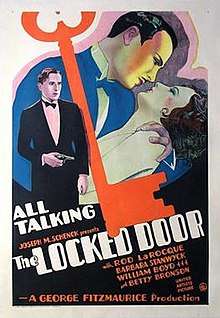The Locked Door
The Locked Door is a 1929 American pre-Code drama film directed by George Fitzmaurice and starring Rod LaRocque, Barbara Stanwyck, William "Stage" Boyd, and Betty Bronson. The film is based on the play The Sign on the Door by Channing Pollock.[1] The play was first adapted for the screen in 1921 as The Sign on the Door, starring Norma Talmadge.[2] The Locked Door was Barbara Stanwyck's second film appearance, first starring role, and first talking picture.

| The Locked Door | |
|---|---|
 Theatrical release poster | |
| Directed by | George Fitzmaurice |
| Produced by |
|
| Written by |
|
| Screenplay by | C. Gardner Sullivan |
| Based on | The Sign on the Door by Channing Pollock |
| Starring |
|
| Cinematography | Ray June |
| Edited by | Hal Kern |
Production company | Feature Productions |
| Distributed by | United Artists |
Release date |
|
Running time | 74 minutes |
| Country | United States |
| Language | English |
Plot
Ann Carter, an inexperienced young woman, accepts an invitation to dinner from Frank Devereaux, the son of her employer. The date turns out to be far from what she expects. It is aboard a "rum boat", a ship that sails beyond the 12 mile limit to get around the restrictions of Prohibition. Worse, Frank turns out to be a cad. When she tries to leave, he locks the door and tries to force himself on her, tearing her dress. The ship drifts back into U.S. waters and a police raid stops him from going any further. When a photographer takes a picture of the two under arrest, Frank buys it from him.
Eighteen months later, Ann is happily married to wealthy Lawrence Reagan. They are about to celebrate their first wedding anniversary when Frank resurfaces in Ann's life, this time as the boyfriend of her naive young sister-in-law, Helen. Though both Ann and her husband tell Helen that Frank is no good, as Lawrence knows that Frank is having an affair with the wife of one of his friends, it is clear to Ann that Helen does not believe them.
Ann goes to Frank's apartment to stop him from taking advantage of Helen. She hides when Lawrence shows up unexpectedly. He warns Frank to leave town before Lawrence's friend catches up with him and shoots him. Frank had already planned to go, but when Lawrence declares that he intends to administer a beating first, Frank draws a gun. He is shot in the ensuing struggle. Lawrence leaves without being seen, unaware that his wife has heard the whole thing.
To protect her husband, Ann phones the switchboard operator and reenacts her earlier assault, ending with her firing two shots. When the police arrive, the district attorney soon pokes holes in her story. Also, the photograph is found, providing a motive for murder. However, Frank is not yet dead; in his last few minutes of life, he explains what really happened, exonerating both Ann and Lawrence.
Cast
- Rod LaRocque as Frank Devereaux
- Barbara Stanwyck as Ann Carter
- William "Stage" Boyd as Lawrence Reagan
- Betty Bronson as Helen Reagan
- Harry Stubbs as the Waiter
- Harry Mestayer as the District Attorney
- Mack Swain as the Hotel Proprietor
- ZaSu Pitts as the Telephone Girl
- George Bunny as the Valet
- Purnell Pratt as Police officer
- Edgar Dearing as Policeman
- Mary Ashcroft as Rum boat girl
- Violet Bird as Rum boat girl
- Eleanor Fredericks as Rum boat girl
- Martha Stewart as Rum boat girl
- Virginia McFadden as Rum boat girl
- Lita Chevret as Rum boat girl
- Leona Leigh as Rum boat girl
- Greta von Rue as Rum boat girl
- Dorothy Gowan as Rum boat girl
- Kay English as Rum boat girl
References
- White Munden, Kenneth, ed. (1997). The American Film Institute Catalog of Motion Pictures Produced in the United States: Feature Films, 1921-1930. University of California Press. p. 445. ISBN 0-520-20969-9.
- White Munden 1997 pp.715-716
External links
- The Locked Door at the TCM Movie Database
- The Locked Door on IMDb
- Progressive Silent Film List: The Locked Door at silentera.com
- Synopsis at AllMovie
- Stills at barbara-stanwyck.com